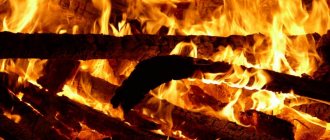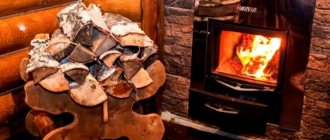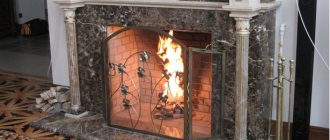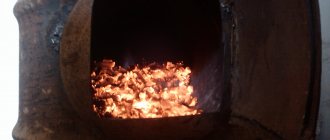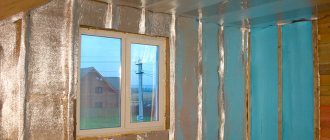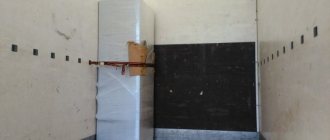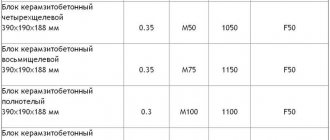Verb conjugation definition
To determine, for example, what conjugation of the verb “to prick”, you need to look at what it ends with. Ends with -ot. Now let's look at the table.
| First conjugation | Second conjugation |
| Shave Lay | Everything is on -it (except for the exceptions of shaving, laying) |
| All verbs end in -at (except for four exceptions in the adjacent column) | Four verbs starting with -а:
|
| Everything is in place (except for the exceptions in the adjacent column) | Seven on -et:
|
| Everything is on -ut, -ot, -yt, -yat. |
This means that the verb “prick” has the first conjugation.
Devices for chopping wood
Swinging a cleaver is only great at first. Then my arms and back hurt. And I already want some devices to make life easier. And a lot of them have already been invented. From simple “their people” to very technological ones. But few people will use high-performance installations in a private backyard, so let’s consider ideas suitable for implementation in everyday life.
The first thing people pay attention to is the weapon. Sometimes design ideas come up with amazing solutions
For example, here is a cleaver with wheels. It probably won't get stuck in the deck. But how long it will last is the question.
Improved firewood cleaver: wheels have been added to prevent it from getting stuck in a log
There is also a device to ensure that the logs do not fly apart during cutting. Here, for example, is this.
Folk device for chopping wood
Or a more technologically advanced option - a metal chain placed on a block of wood. How to handle it - watch the video. A master works here.
There are also a variety of devices for chopping wood: mechanical, hydraulic, electric or with motors running on gasoline/diesel fuel. Mechanical wood chopping is a machine in which a log of wood is fixed. Then, using a system of levers, the cleaver is activated. Such devices can have different types, some can immediately chop a log into several parts, but the principle is still the same.
A hydraulic firewood splitter is designed on the same principle, but the force is created by a hydraulic jack. It can be operated using the power of the arms or legs or using a motor. Can be of different power and configuration. The choice on the market is quite large, but the prices are not low. In the video you will see one of the options for a hydraulic jack.
A very interesting option using a cone. Moreover, such a homemade cleaver for firewood is not difficult to make. It feels easy to chop wood without an ax (the video demonstrates this very well).
This electric firewood splitter is becoming increasingly popular - it's easy to make and has excellent performance. But when working on it, we must not forget about safety precautions: one wrong move and injury is guaranteed.
And now the promised video - Adriano Celentano chopping wood. As you understand, he did this for a reason.
Conjugate
To conjugate is to change the persons and numbers of verbs in the present and future tense.
| Singular | In plural | |||
| 1st reference | 2nd reference | 1st reference | 2nd reference | |
| 1st person (I, we) | -у(-у) | -у(-у) | -eat | -them |
| 2nd person (you, you) | -eat | -hey | -yeah | -ite |
| 3rd person (he, she, it, they) | -et | -it | -ut(s) | -at(-yat) |
Now that we know that the verb “prick” has the first conjugation, we can inflect it:
- 1st person - I stab, we stab.
- 2nd person - you stab, you stab.
- 3rd person - he stabs, they stab.
Spelling the word "pricks"
Let's find out how to spell the word "kolet" correctly, with the letter "e" or "i" by determining the conjugation of the verb.
To choose the correct spelling of the unstressed personal endings of the verb forms “kolet”, “kolesh”, “kolete”, we turn to the infinitive “to prick”, which ends in -ot. This means that this verb changes according to the first type of conjugation, like the words “pol ot”, “pray”, “fight”.
Let's see how the verb “to prick” changes in the present tense according to persons and numbers:
Let us conclude: in the unstressed ending of the word “kolet” and most forms of the first conjugation verb “to prick” the letter “e” is written.
The word “kolet” is written with the letter “e” in the unstressed ending -et as a form of the verb “to prick” of the first conjugation.
Examples
Igor chops dry logs into small chips to quickly light a fire.
For some, nothing stings the eyes more than a speck in someone else's house.
It seems like I have something tingling in my side.
Similarly, we will learn how to correctly write the following words with the letter “e” or “i”:
Source of the article: https://sprint-olympic.ru/uroki/russkij-jazyk-uroki/kak-pravilno-pishetsja/42344-kolet-ili-kolit-kak-pravilno.html
Exercises
1. Before you are sentences, you need to insert letters instead of dots into them; to do this, remember what the conjugation of the verb “to prick” is.
- Wood is chopped not with an axe, but with a cleaver.
- There’s something in my side, I need to rest.
- We will definitely split it...m.
- What do you use to sting the torch?
- How much wood do you chop today?
- Vadik decided that he would get a tattoo all over his back.
- The sweater is terribly itchy.
- The thorns of the rose are pricking, be careful.
- We'll pin your braids up and it will be beautiful.
- You make fun of us, but then no one will believe you.
- Be careful, otherwise the branches will poke out your eyes... etc.
- Use a needle all over your hands until you sew on the collar.
- Then pin the brooch to the collar, and everything will be fine.
2. Do the same in the text:
It’s good in the forest in the spring, when life awakens.. It's snowing. The cheerful voices of birds are heard more and more. Thaws appear in the clearings, snowdrops grow. On the hummocks you can see last year’s leaves.
You will hear a lot in the forest in the spring. At the top of the spruce tree there is a singing thrush. A hazel grouse is whistling thinly, and cranes are fiddling around in the swamp.
Spelling the word "pricks"
In the yard, Stepan chops wood to light the stove.
To choose the correct spelling of the unstressed personal endings of the verb forms “kolet”, “kolesh”, “kolete”, let’s turn to the infinitive “to prick”, which ends with the letter combination -ot. This means that this verb changes according to the first type of conjugation, like the words “pol ot”, “pray”, “fight”.
Let's see how the verb “to prick” changes in the present tense according to persons and numbers:
- 1st person I count - we count
- 2nd person you are stabbing - you are stabbing
- 3rd person he stabs - they stabs.
Let us conclude: in the unstressed ending of the word “kolet” and most forms of the first conjugation verb “to prick” the letter “e” is written.
To learn the correct spelling of this word form of the verb, let’s read example sentences.
Examples
Igor chops dry logs into small chips to quickly light a fire.
For some, nothing stings the eyes more than a speck in someone else's house.
It seems like I have something tingling in my side.
Similarly, we will learn how to correctly write the unstressed endings of the following words with the letter “e” or “i”:
Source of the article: https://russkiiyazyk.ru/orfografiya/pravopisanie/kak-pravilno-pishetsya-slovo-kolet-ili-kolit.html
Formation of participles
From verbs, a part of speech is formed, denoting the attribute of an object by action. They are called participles. Such words are formed from the base of verbs with the help of suffixes, some of which depend on the conjugation.
Formation of active present participles:
- from verbs of the first conjugation – -ushch (-yushch);
- from verbs of the second conjugation – -ashch (-yashch).
Formation of passive past participles:
- from verbs of the first conjugation – -ем (-ом);
- from verbs of the second conjugation - -im.
Examples of forming participles:
- see - seeing, visible;
- shine - shining.
Example of using participles: The entire panorama visible to the eye was filled with shining light.
Security measures
Any operations with piercing and cutting tools must be carried out in compliance with appropriate safety measures:
- Strengthen the ax the day before chopping. Place it in a bucket of water, the ax handle will swell, and the cleaver will sit firmly. It is better, of course, to keep it in water for several days. This measure is only applicable for tools with a wooden handle. If the handle is made of metal or plastic, then the operation is useless. You will have to check the strength of the structure manually.
- If an ax is used, it must be well sharpened. It is necessary to sharpen the ax before each felling.
- Make sure that there is no one within a radius of three meters from the deck. Also, do not chop wood close to the windows, as logs may fly there. An inexperienced woodcutter can leave more empty space around.
- Do not try to split along the knot; the cleaver may either fly off or get stuck tightly.
- Do not wear mittens; they may slip off your hand or change the force of the blow. This poses a risk of injury. Only gloves can be worn.
- When using mechanization tools, keep your hands as far as possible from the cutting tool.
After cutting, you need to put the firewood in a woodpile, leaving air space between them. It is better to stack the woodpile after finishing the entire cutting process. Gradually, the work of chopping wood will become familiar and the speed will increase significantly.
Test
1. There is such a task among the exams, which are aimed at identifying the level of knowledge of graduates of spellings associated with the endings and suffixes of verbs and words derived from them. Below are examples that use words, including the verb “to stab,” the conjugation will help you make the right choice. You need to fill in the missing letters.
- saw...cut boards in the yard;
- breathe...sew through a straw;
- write an essay about summer;
- calm down before the exam;
- cleared of debris;
- take it at dinner;
- fanned...by a light breeze;
- shave your beard every day;
- caught...my locator;
- you hate boredom and dullness;
- I hear...my from somewhere far away;
- you move ten kilometers a day;
- returning from a business trip;
- bend... around the perimeter;
- covered...by the media;
- I've been planning for the whole year;
- sharp object;
- scandal... over trifles;
- hide for a long time;
- you drive around all day;
- aim at the target;
- illuminates the site;
- driven by good ideas;
- split off from a whole piece;
- fistula on the street;
- encouraging...my friends;
- having opened... my secrets behind the veil.
- solving...mine is very simple;
- chasing criminals;
- tormented by remorse;
- deciding...my on the spot;
- hide from your pursuers.
2. In all the sentences given below, there is the word “prick”; we have already determined the conjugation of the verb. You need to put this verb in the correct form.
- My whole life tomorrow (split) into two parts: before entering college and after.
- I know that my opinion is to (split) everyone gathered into two warring camps.
- We (pin) our exhibits on pins and place them at the exhibition.
- The heat will break the stones, and it will be possible to plant explosives.
- Tomorrow his whole life (split) into two halves: before school and at school.
- Thunder rumbled - now lightning (split) the sky in half.
3. Give an answer to the question: “How to determine the verb conjugation of “kolet”?”
______________________________________________________________________
What is needed to split wood?
- Deck.
This is a thick cut of wood installed vertically. The deck must be at least half a meter high and have a sufficiently large diameter. The knottier the deck, the stronger it will be. Outside you need to leave a couple of knots that will serve as handles for dragging.
The stump for the deck is best taken from oak or elm. If there are none, you can use thick birch, but such a deck will last less.
- Ax or cleaver
An ax with a sharp blade is needed for chopping thin logs, removing knots, and preparing wood chips. There are different types of cleavers. A heavy cleaver with a blunt blade wedges thick logs, dividing them into parts. Lightweight cleavers have a blade shape in the form of a sharpened wedge or a classic one.
The cleaver must be selected correctly. Of course, the handle should be comfortable and fit the width of your palm. The weight is also selected “to suit you”, taking into account the fact that you will have to swing. The handle should be birch, the hand fits well on it. Plastic or metal slides. There are rubberized handles, they are comfortable, but they are usually found on expensive instruments.
- Wedges.
Can be useful for splitting hard, thick tree cuts. It is used in addition to the cleaver used to pierce the log. A wedge is inserted into the crack formed. Hammered with a sledgehammer to split the log. Wedges can be smooth or jagged.


